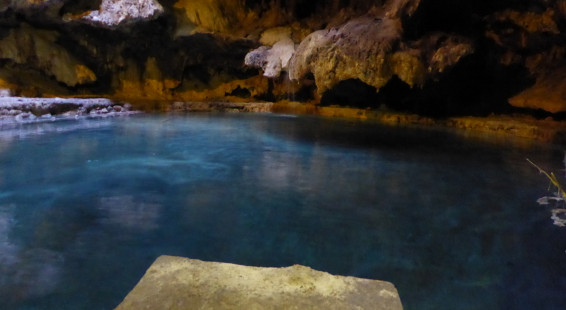
The Cave and Basin National Historic Site is a small site just outside the town of Banff, but is important to Canadians because it was a catalyst to the formation of Canada’s first national park, Banff National Park.
Historic aspects
The Cave and Basin is the lowest of nine sulphurous hot springs, arranged in three groups, on Banff’s Sulphur Mountain. The water is heated geothermally at a depth of about 3 km (2 mi) and escapes to the surface at these sites. The Cave and Basin is the only natural cavern in the area big enough to comfortably accommodate groups of people.
Humans have inhabited this region for at least 10,000 years, back to the retreat of the massive ice flows from the last period of great glaciation (I, for one, am very glad that the kilometer thick sheet of ice is gone). It’s very likely these hot springs were used by aboriginals for hundreds if not thousands of years. Imagine the magical luxury to prehistoric people of a warm clean bath on a cold winter night!
Canadian Pacific Railway workers, William McCardell and Frank McCabe, were the first to realize the commercial importance of the site and their actions brought national attention to the Cave and Basin. In 1883 they entered the grotto through the skylight entrance using a fallen tree and liked what they saw. The following year they constructed a small cabin nearby intended to help attract tourists to the site. Conflicting claims by others prompted intervention by the government of the then brand new nation of Canada. In 1885, the government created a 10 square miles (26 km2) reserve around the Cave and Basin, the Banff Hot Springs Reserve. It was to be the first piece of what has become Canada’s great national parks system.
In 1886 an artificial tunnel — a controversial construction even then — was driven into the Cave and Basin to facilitate visitor’s access. In 1912 water was bottled from the Cave and Basin site and sold for medicinal purposes. In 1914 a naturally heated outdoor swimming pool was opened to the public which continued to operate until 1994, when it closed. I actually remember visiting this pool with my family during summer vacations when I was a boy. Today many visitors to Banff visit the Upper Hot Springs, a separate site some 5 km (3 mi) from the Cave and Basin.

Cave and Basin, 1920
The Cave and Basin was formally declared a national historic site in 1981. It is home to the most endangered animal in Banff NP, the Banff Springs Snail, a corn kernel sized mollusk that lives in these warm mineral rich water and survives on algae. This snail is found only in the geothermal waters of Sulphur Mountain.
Visiting Today:
The Cave and Basin site is easily reached by car, but I’d recommend you walk there from the town of Banff, as I did. It’s an easy fairly flat 20 minute walk and there’s some beautiful scenery to enjoy along the way. On the day I visited the air was somewhat hazed by the smoke from a USA wildfire, but even with the smoky air you can still appreciate the awesomeness of the place. The walk starts beside the beautiful Bow River, turquoise in color because of the glacial silt in its summer runoff.
The path turns inland, through a community park including a large bike activity park with jumps and obstacles. A small diversion takes you past Warner stables, a great place to arrange for a horseback or wagon ride.

Bow River near Cave and Basin
The last stretch of the walk takes you beside some marshland, again with wonderful mountain views. At the Visitor Center you check in, show your park pass (or pay a modest admission fee), then walk up towards the historic Cave and Basin site. The views from the Cave and Basin site towards the eastern Bow Valley are very beautiful.
Before entering and exploring the building, I’d recommend you head further up the hill for a short nature walk to see the source of the hot springs. There’s a great boardwalk so it’s easy to get around despite the swampy nature of the terrain. The water is warm, steams a little, and has thick growth of colorful algae. You can also see the historic cave entrance, now covered by a grate. On your way back, stop at the thermal pool beside the complex of buildings and enjoy the hot, colorful bubbling water.
Now you’re ready to explore the buildings. The facilities include an artificial tunnel to the beautiful natural grotto (the Cave), still an impressive site. There’s also a replica of the original 1887 bathhouse, the restored 1916 swimming pool and structure, and a variety of historic and interpretive displays. All in all, an interesting few hour stop to be included in your Banff itinerary.
Click on thumbnails to enlarge, then right arrow to advance slideshow)